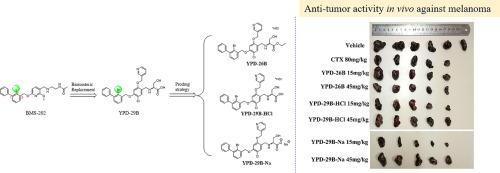溴苯苯醚衍生物YPD-29B的发现:一种新的临床前化合物,靶向程序性细胞死亡-1/程序性细胞死亡-配体1 (PD-1/PD-L1)相互作用
IF 3
3区 医学
Q2 BIOCHEMISTRY & MOLECULAR BIOLOGY
引用次数: 0
摘要
利用小分子靶向PD-1/PD-L1免疫检查点通路已显示出巨大的前景。为此,为了开发具有良好活性、药代动力学性质和可药物性的抑制剂,我们合成并筛选了一系列新的联苯2位卤素取代衍生物,并通过HTRF实验评估了它们对PD-1/PD-L1蛋白-蛋白相互作用(PPI)的抑制活性。其中,YPD-29B表现出较强的活性,IC50值小于1 pM。此外,基于pbmc的PD-1/PD-L1阻断生物实验表明,在细胞水平上,YPD-29B浓度为10 nM时,可以抑制PD-1/PD-L1相互作用,恢复t细胞功能,IC50值为0.18 nM。然而,YPD-29B的溶解度较差,限制了其体内抗肿瘤活性的评价。因此,我们设计合成了YPD-29B的前药、钠盐和盐酸进行动物实验,结果显示,与阳性对照CTX相比,YPD-29B- na具有明显的抗黑色素瘤活性,TGI为64.11%,对血液指标和体重的毒性较弱。不同治疗组肿瘤T淋巴细胞浸润明显增加,提示免疫系统激活。通过分子对接验证了设计的合理性。作为YPD-29B的前药,IMMH-010已被NMPA批准进入临床I期。我们希望这些结果能够为PD-1/PD-L1小分子抑制剂的开发提供一个新的视角。本文章由计算机程序翻译,如有差异,请以英文原文为准。

Discovery of bromobenzyl phenyl ether derivative YPD-29B: a novel pre-clinical compound targeting the programmed cell death-1/programmed cell death-ligand 1 (PD-1/PD-L1) interaction
Targeting the PD-1/PD-L1 immune checkpoint pathway with small molecules has exhibited great promise. Herein, to develop the inhibitors with good activity, pharmacokinetic properties and druggability, a novel series of halogens substituted derivatives at the 2-position of the biphenyl group were synthesized, screened, and their inhibitory activity against the PD-1/PD-L1 protein-protein interaction (PPI) was evaluated through a HTRF assay. Among them, YPD-29B exhibited potent activity with IC50 value of less than 1 pM. Furthermore, the PBMC-based PD-1/PD-L1 blockade bioassay revealed that YPD-29B could inhibit the PD-1/PD-L1 interaction and restore T-cell function with the concentration of 10 nM at the cellular level and with the IC50 value of 0.18 nM. However, the poor solubility of YPD-29B limited the evaluation of antitumor activity in vivo. Thus, the prodrug, sodium salt and hydrochloride of YPD-29B were designed and synthesized to conduct the animal experiments, revealing the obvious anti-melanoma activity of YPD-29B-Na with TGI of 64.11 % and weak toxicity on the blood index and the body weight compared with the positive control CTX. T lymphocyte infiltration markedly increased in tumors of the different treated groups, suggesting the activation of the immune system. Besides, molecular docking verified the rationality of the design. IMMH-010, as a prodrug of YPD-29B has been approved for clinical phase I by NMPA. We hope these above results could offer a novel perspective for the development of PD-1/PD-L1 small molecule inhibitors.
求助全文
通过发布文献求助,成功后即可免费获取论文全文。
去求助
来源期刊

Bioorganic & Medicinal Chemistry
医学-生化与分子生物学
CiteScore
6.80
自引率
2.90%
发文量
413
审稿时长
17 days
期刊介绍:
Bioorganic & Medicinal Chemistry provides an international forum for the publication of full original research papers and critical reviews on molecular interactions in key biological targets such as receptors, channels, enzymes, nucleotides, lipids and saccharides.
The aim of the journal is to promote a better understanding at the molecular level of life processes, and living organisms, as well as the interaction of these with chemical agents. A special feature will be that colour illustrations will be reproduced at no charge to the author, provided that the Editor agrees that colour is essential to the information content of the illustration in question.
 求助内容:
求助内容: 应助结果提醒方式:
应助结果提醒方式:


